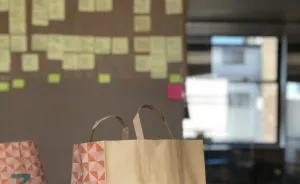In our last blog we talked about our interviews with GPs, nurses and front line staff, and the use of How Might We’s to frame the design opportunities in four key problem areas. These challenges are experienced by Henfield Medical Centre but research shows us they are shared across primary care.
Guerilla research
To move forward with more in depth research we narrowed our focus towards the two interrelated areas: self-care (how can self-care information and uptake be better integrated in the GP patient journey) and the practice of triaging patients (could design improve the efficiency of triage?). Although we had important insight from the practice side we wanted to speak to people in the community. We visited Henfield, using guerilla research techniques to gain fast insight. We were left struck by the different understandings of self care and attitudes towards the role of GPs.
Synthesising the opportunities
Back in the studio we hit a decision wall, and we thought that was the time to elicit some advice from more experienced Clearflefties. Encouraged to diverge our thinking again to check we had considered all the opportunity areas we ran a How Might We’s rethinking session. We individually wrote HMW statements before theming these and dot voting. Here we met our first plot twist, bringing the topic of ‘reassurance’ back to the drawing board (the reliance on GPs for sometimes unnecessary reassurance).

We crafted problem statements in these target areas so we were clear on our users, user needs and impact of the problems. But we needed one problem statement to move forward with! With different views in the team we mapped out the opportunities in these areas, as well as the challenges we faced if designing for these. From this we used the ‘NUF’ technique, comparing our initial broad concepts for these problems in terms of how new, useful and feasible they are.

From the research there were some clear personas of patients that we hadn’t yet mapped out on paper. So using our best friend the post it, we assessed what we considered relevant to understand in the context of this project and brought these groups of people to life against these metrics. These included typical self-care practices, attitudes to GP care and of course needs. It was important to clarify the different needs and goals of users before designing for one.
Playback and next steps
Nearing the end of discovery we wanted to bring the rest of the team in the project in greater depth, so we hosted a ‘brown bag’ lunch. Something us designers need to be able to do in the ‘real world’ is present our work to stakeholders. As such we prepping as one would for a client playback, beginning with storyboarded the project journey so far. This helped us take the high level view of the process before surfacing all the findings, methods, quotes, insights and learnings along the way that enriches the picture.

All of this research has helped us move into the design phase! We’ve run a design studio with fellow colleagues, and ideation sessions with stakeholders. We realised we needed more data to be confident in our designs so alongside starting the idea development phase we are gathering more user insight via a survey. This is also giving us access to people to interview or test concepts on before moving to implementation.
You can follow us on twitter @clearleftintern for regular updates on the project.